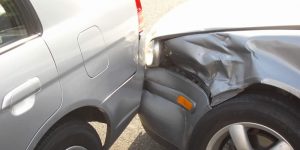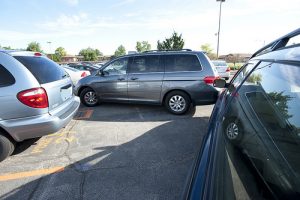Right-Of-Way in a Parking Lot
While traversing the lines of parking spots, some may get confused by who exactly has the right-of-way. The best way to determine this is by considering what type of lane you are in. Parking lots have two basic types of lanes: thoroughfares and feeder lanes.
A thoroughfare is a lane that exits to a street. These tend to be wider and are the main arteries of the parking lot. Feeder lanes, on the other hand, are smaller lanes that begin and end at the thoroughfares. Those who are driving in a thoroughfare have the right-of-way over those coming out of feeder lanes. That means that you must stop and allow traffic in the thoroughfare to proceed before moving out of a feeder lane.
Similarly, anyone who is moving out of a parking space must yield to those who are driving through the lane. Just like a car coming out of a driveway onto a street, vehicles in a parking space do not have right-of-way over those already proceeding.
Finally, all stop and yield signs in a parking lot should be observed the same way as signs on any street. Failure to obey posted signs can leave you at fault in a resulting accident.
Common Parking Lot Accidents

One of the most common accidents to occur in a parking lot is one in which a driver is backing out of a space and strikes another vehicle, whether moving or parked. The driver backing out of the parking space will usually be found at fault for the collision with one exception: in a case where two cars are backing out at the same time and hit each other, fault is likely to be shared.
Typically, any situation in which you strike a legally parked vehicle will find you at fault. This includes backing into a parked car, striking a car with your door when opening it, or clipping it in the lot. If you hit a parked car and leave the scene without making an effort to contact the owner of the car, it can also be considered a hit-and-run.
It’s also vital that all drivers be aware of the presence of pedestrians when driving in a parking lot, as they are walking between stores and cars and are present in greater numbers than on the average street.
How Insurance Companies Determine Fault
Just like any accident on the street, insurance companies will take statements and consider damage to all vehicles involved in a parking lot accident to determine fault.
Parking lots are subject to fault determination rules, which are predetermined guidelines by which adjusters can quickly determine fault. Cooperating and providing accurate information are the best things you can do to ensure fair fault determination.
However, you also have the right to appeal the insurance company’s decision if you do not believe you are at fault. A third party mediator can be brought in to make an objective decision on the claim.
Avoiding Parking Lot Accidents

There are many cars and pedestrians going in multiple directions in a large and busy lot, so cautious driving is the best and easiest way to avoid being involved in a collision.
Always slow down and proceed carefully in parking lots. Reverse very slowly and watch for pedestrians, cars coming down the lane, or even cars backing out of other spots.
It can be very difficult to see when backing out of a spot next to a large vehicle such as a van; when proceeding through the lanes watch out for cars that might be backing out with blind spots, and allow them to continue to back out slowly until they make eye contact with you. While they might be at fault in an accident, it’s up to all drivers to avoid preventable accidents.
